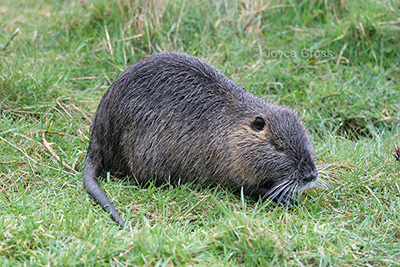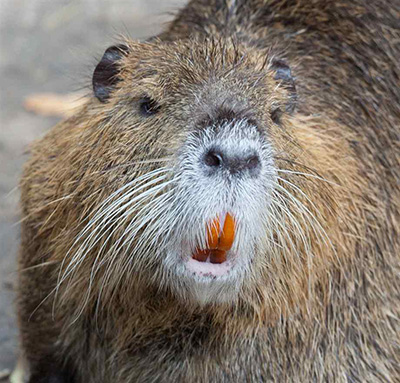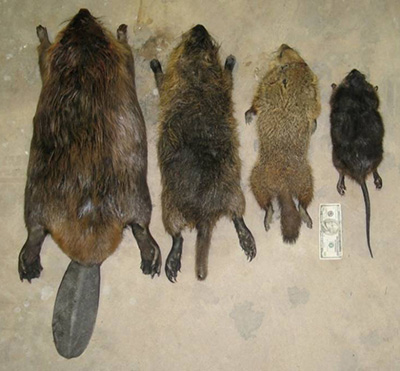Myocastor coypus
General Description
 An adult nutria with white muzzle and whiskers, and long, round tail. Photo courtesy of Joyce Gross, UC-Berkeley.
An adult nutria with white muzzle and whiskers, and long, round tail. Photo courtesy of Joyce Gross, UC-Berkeley.
 The white muzzle and conspicuous, white whiskers are distinguishing characteristics of the nutria. Photo courtesy of Tony Northrup.
The white muzzle and conspicuous, white whiskers are distinguishing characteristics of the nutria. Photo courtesy of Tony Northrup.
 Left to right: beaver, nutria, groundhog, muskrat. An adult nutria is about 1/3 the size of an adult beaver and over 5 times the size of a muskrat. Beavers have broad, dorsally-flattened (top to bottom) tails and black whiskers. Muskrats have virtually hairless, laterally-flattened (side to side) tails and black whiskers. The nutria in this image has a stub-tail, likely caused by frostbite. Neither beavers nor muskrats have a white muzzle or white whiskers. Photo courtesy of the Skagit Nutria Advisory Committee.
Left to right: beaver, nutria, groundhog, muskrat. An adult nutria is about 1/3 the size of an adult beaver and over 5 times the size of a muskrat. Beavers have broad, dorsally-flattened (top to bottom) tails and black whiskers. Muskrats have virtually hairless, laterally-flattened (side to side) tails and black whiskers. The nutria in this image has a stub-tail, likely caused by frostbite. Neither beavers nor muskrats have a white muzzle or white whiskers. Photo courtesy of the Skagit Nutria Advisory Committee.
The nutria is a large, light- to (typically) dark-brown, fur-bearing, aquatic rodent. Nutria strongly resemble beavers, but with arched backs and long, round, sparsely-haired tails, rather than wide and flattened like the beaver. Adults typically reach a body length of 2 ft., weigh 15-20 lbs., and have tails 1-1.5 ft. long. Nutria tracks can reach up to 6 inches long, have 5 toes per foot, and have webbing on the hindfeet, which is often visible in tracks. An adult nutria is about one-third the size of an adult beaver, and over 5 times the size of a muskrat, which has a thin, laterally-flattened (side to side), nearly triangular tail. Nutria are distinguished from beavers and muskrats by their long, white whiskers and rounded tails; beavers and muskrats have black whiskers and flattened tails (see nutria ID guide (PDF)(opens in new tab)). Once introduced, nutria populations increase rapidly; nutria reach sexual maturity as early as 4-6
months of age and can produce their first litter by 8 months of age. They breed year-round, producing up to 3 litters per year, with 2-13 young per litter.
Current Distribution
Nutria were originally introduced to the U.S. (Elizabeth Lake, California) for the fur-trade in 1899, but failed to reproduce. Subsequent introductions were successful, as records indicate nutria were present in the Central Valley and South Coast of California in the 1940s and 50s, but were eradicated from the state by the 1970s. There are established populations of nutria on every continent except Antarctica and Australia. In the U.S., nutria have been found in 30 states, but are currently established in as many as 18, including Washington, and Oregon. In 2017, a reproducing population of nutria was discovered in California’s San Joaquin Valley. For the latest information, please visit Discovery of Invasive Nutria in California.
Habitat Preference
Nutria are found near permanent water sources, such as rivers, streams, lakes, ponds, and wetlands. Though common in freshwater, nutria also inhabit brackish coastal water areas. Native to South America, nutria thrive in warmer climates, and their reproductive success is reduced by severe winter conditions.
Pathways
During the 1930s, introductions to several states for development of “nutria ranches” were successful. When the fur market collapsed in the early 1940s, many nutria were released. Throughout the 1940s, agencies and entrepreneurs also promoted and released nutria to control aquatic vegetation. Subsequent ecological impacts led many states to implement eradication efforts. Nutria are restricted in California and cannot be imported, transported, or possessed without a permit.
Impacts
Nutria cause various kinds of damage through burrowing, intense herbivory, and carrying pathogens and parasites. Nutria do not construct dens, they burrow, frequently causing water-retention or flood control levees to breach, weakening structural foundations, and eroding banks. They can consume up to 25% of their body weight in above- and below-ground vegetation each day, but they waste and destroy up to 10 times as much, causing extensive damage to the native plant community and soil structure, as well as significant losses to nearby agricultural crops. The loss of plant cover and soil organic matter (roots, rhizomes, tubers) results in severe erosion of soils, in some cases destroying marshlands and leaving behind open water. The destructive feeding habits of nutria threaten populations of rare, threatened, or endangered species that rely on critical wetland habitats. Nutria also serve as hosts for tuberculosis and septicemia, which are threats to humans, livestock, and pets. Additionally, nutria carry tapeworms, a nematode that causes a rash known as “nutria itch”, and blood and liver flukes, which can contaminate swimming areas and drinking water supplies.
Actions Taken if Found
Suspected observations or potential signs of nutria in California should be photographed and immediately reported to CDFW ONLINE, by email to Invasives@wildlife.ca.gov, or by calling (866) 440-9530. Observations on state or federal lands should be immediately reported to local agency staff. If this species is captured, do not release it, immediately contact your local CDFW office or County Agricultural Commissioner.
References
- Bounds, D.L., Mollett, T.A., Sherfy, M.F., 2001. The Nutria Nuisance in Maryland and the Search for Solutions. Aquatic Invasive Species Digest. v.4, no.3 (PDF)(opens in new tab).
- Invasive Species Specialist Group (ISSG). Myocastor coypus. Global Invasive Species Database.(opens in new tab) Last modified 13 April 2008.
- U.S. Geological Survey – National Wetlands Research Center. Worldwide Distribution, Spread of, and Efforts to Eradicate the Nutria (Myocastor coypus)(opens in new tab).
- Fuller, Pam. 2016. Myocastor coypus. USGS Nonindigenous Aquatic Species Database, Gainesville, FL.(opens in new tab) Revision Date: 5/19/2005.